In short: No changes and no positions. Based on today's pre-market upswings it seems that we might send another alert later today.
Yesterday, gold rallied significantly, mining stocks rallied less significantly (didn’t close higher than on Tuesday) and silver moved higher very insignificantly. Let’s see how much changed (charts courtesy of http://stockcharts.com.)
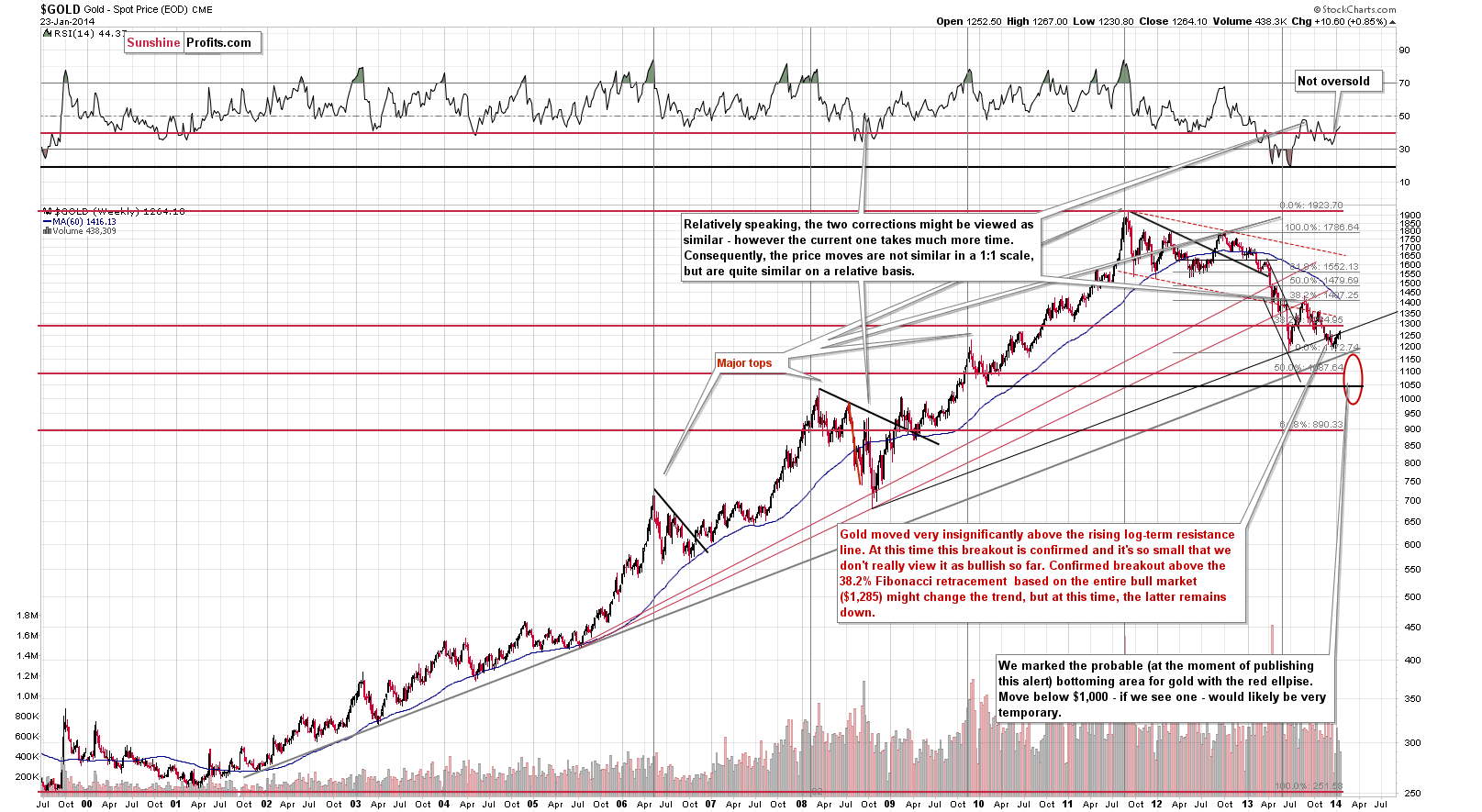
From the long-term perspective, not much changed. The move that we saw on Thursday was significant on a daily basis (as you can see on the chart below), but from the long-term perspective, it didn’t cause significant changes. In fact, there were barely any changes to speak of. Yes, gold closed above the rising long-term support line, but the move above it was so insignificant from this perspective, that it’s not even clear if it really happened. Obviously, we would need to see gold close above this line for at least 2 more trading days, but taking into account the significance of the resistance line discussed, we might need to see something more before we view the breakout as confirmed.
Please note that there is another major resistance quite close to where gold is now. We would still need to see the 38.2% Fibonacci retracement level being taken out (a confirmed breakout) before we can really discuss a change in the medium-term trend, which still remains down.
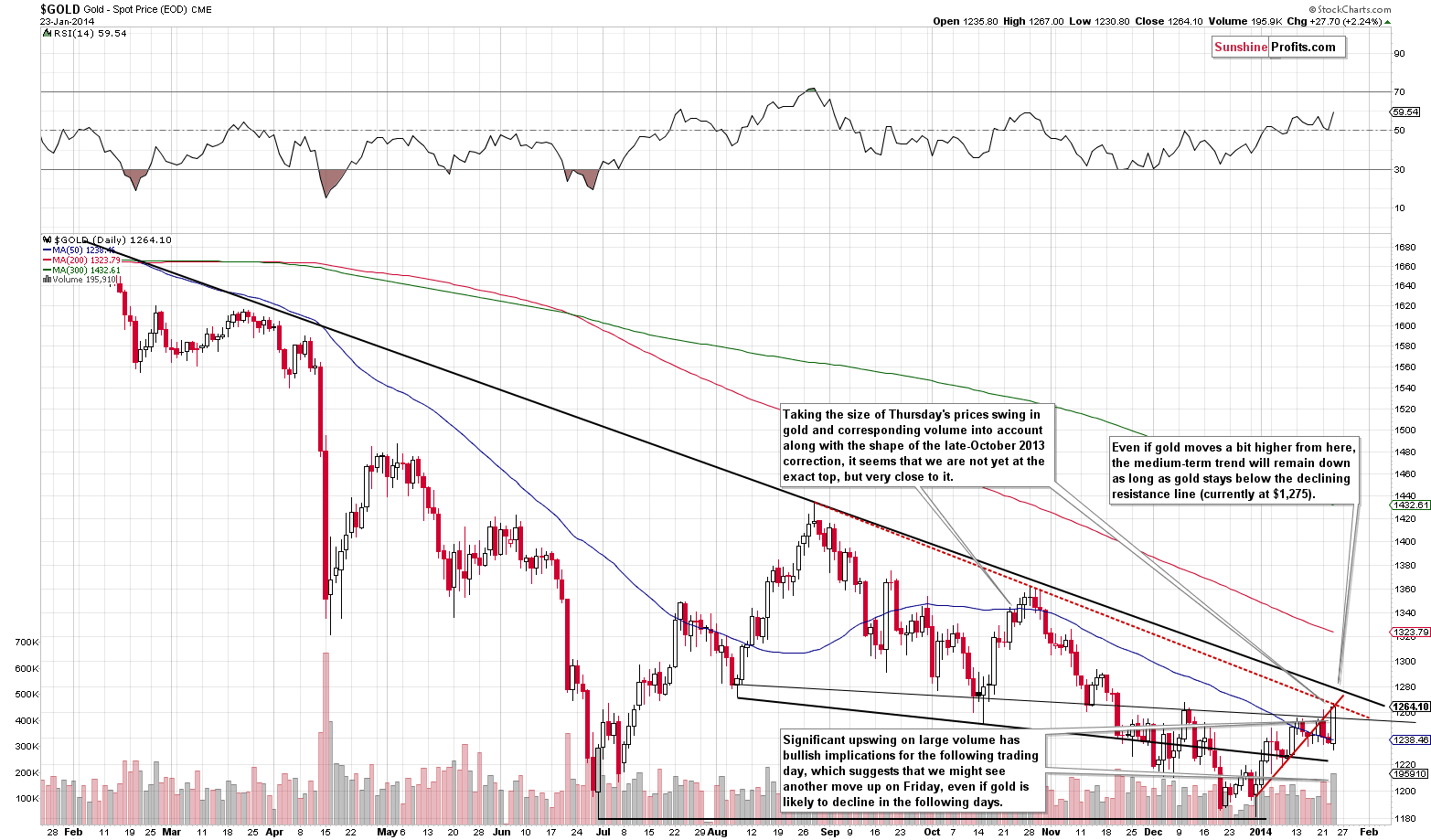
On the above chart, we have a bullish sign – a move above the previous January high that happened on significant volume. Such action is quite likely to be followed by another daily upswing (it doesn’t have to be significant). However, this seems to be the end of positive news.
The move didn’t take gold above the declining medium-term resistance line (black line) and neither did it result in a breakout above the declining short-term resistance line (red, dashed line).
Combining the implications from the two above paragraphs, we get a picture in which gold would be likely to rally on Friday or on one of the following days, but this rally would take gold only to the declining medium-term resistance line (approximately to $1,275) and after that the yellow metal would be likely to decline once again.

Taking the Dow to gold ratio into account, we see a post-breakout correction. It’s worth noting that the correction has begun sort of “by itself” – without reaching any significant resistance line. This makes it more likely that the move is just a correction and not a real decline in the ratio (meaning a rally in gold).
Moving on to the silver chart, we see something much less bullish.
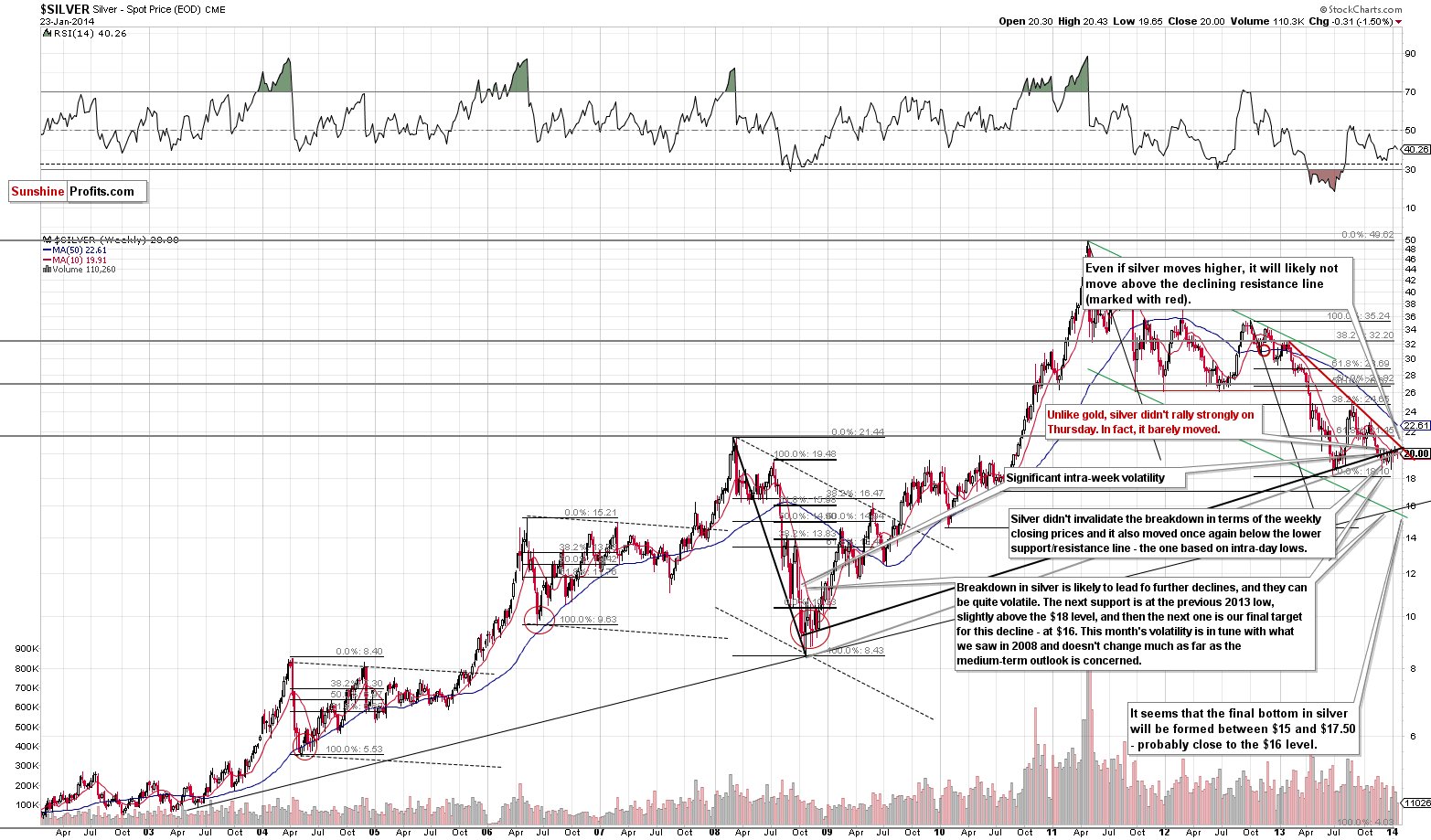
Silver moved significantly lower earlier this week and the situation didn’t really improve yesterday. Silver moved only slightly higher and it is still down $0.31 for the week. The trend clearly remains down as there was no breakout above both rising long-term support/resistance lines.
Meanwhile, gold stocks moved higher, but not that significantly.
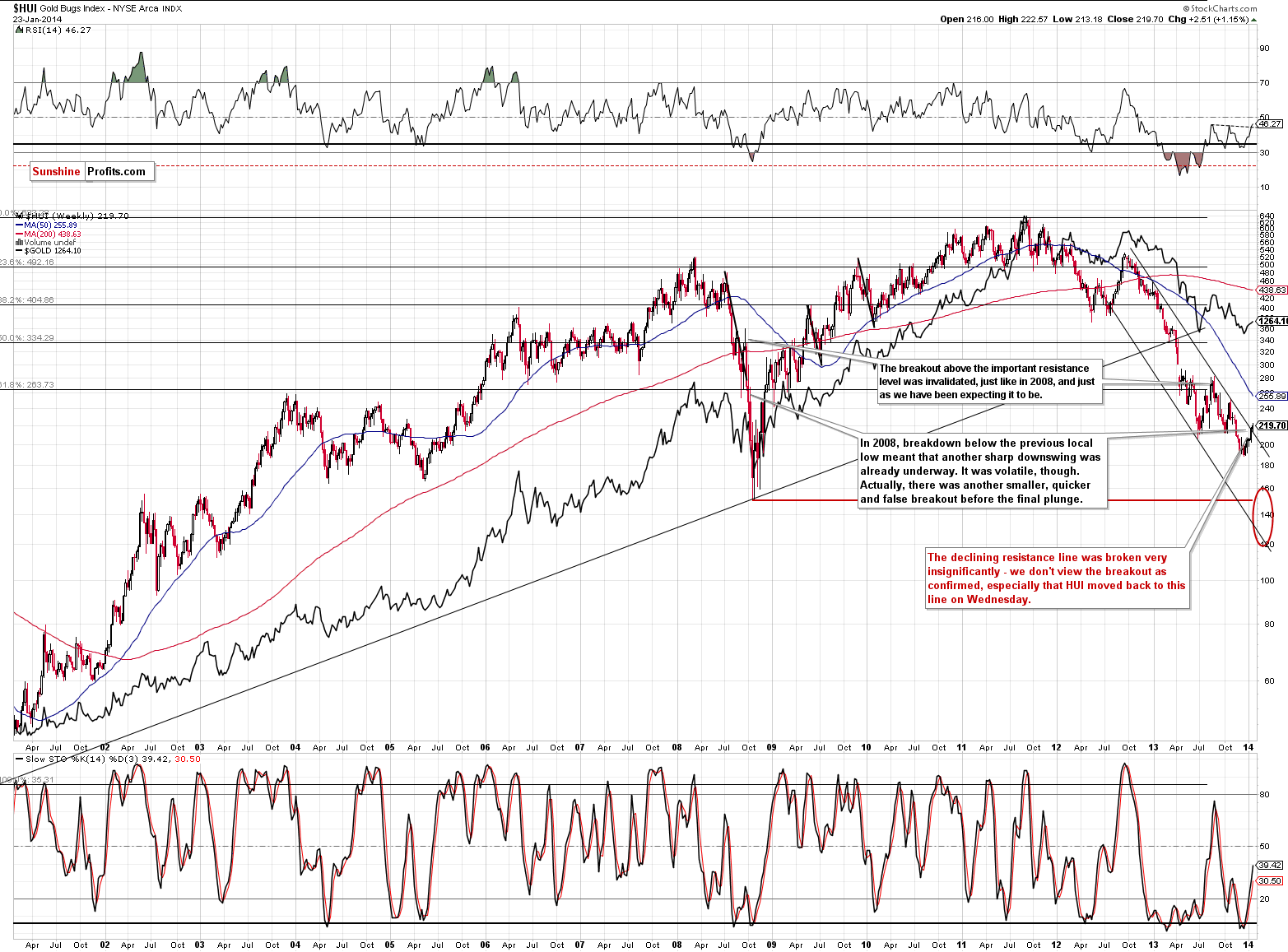
Gold miners moved higher recently, but not to the extent that would suggest the medium-term trend is already up. Yes, we saw a very small (!) move above the declining resistance line, but just as it was the case with gold, we would need to see a confirmation of this move.
This is particularly the case because we saw something similar right before the final part of the plunge in 2008. History repeats itself to some degree and the current decline is in our opinion most similar to the only other major decline that we saw since the beginning of this bull market. Back then there was one major correction within the decline (we saw one in mid-2013) and then one small one. We have a small breakout right now.
So, how bullish is it, really? "Mildly" is our best answer at this time.
What about silver stocks?
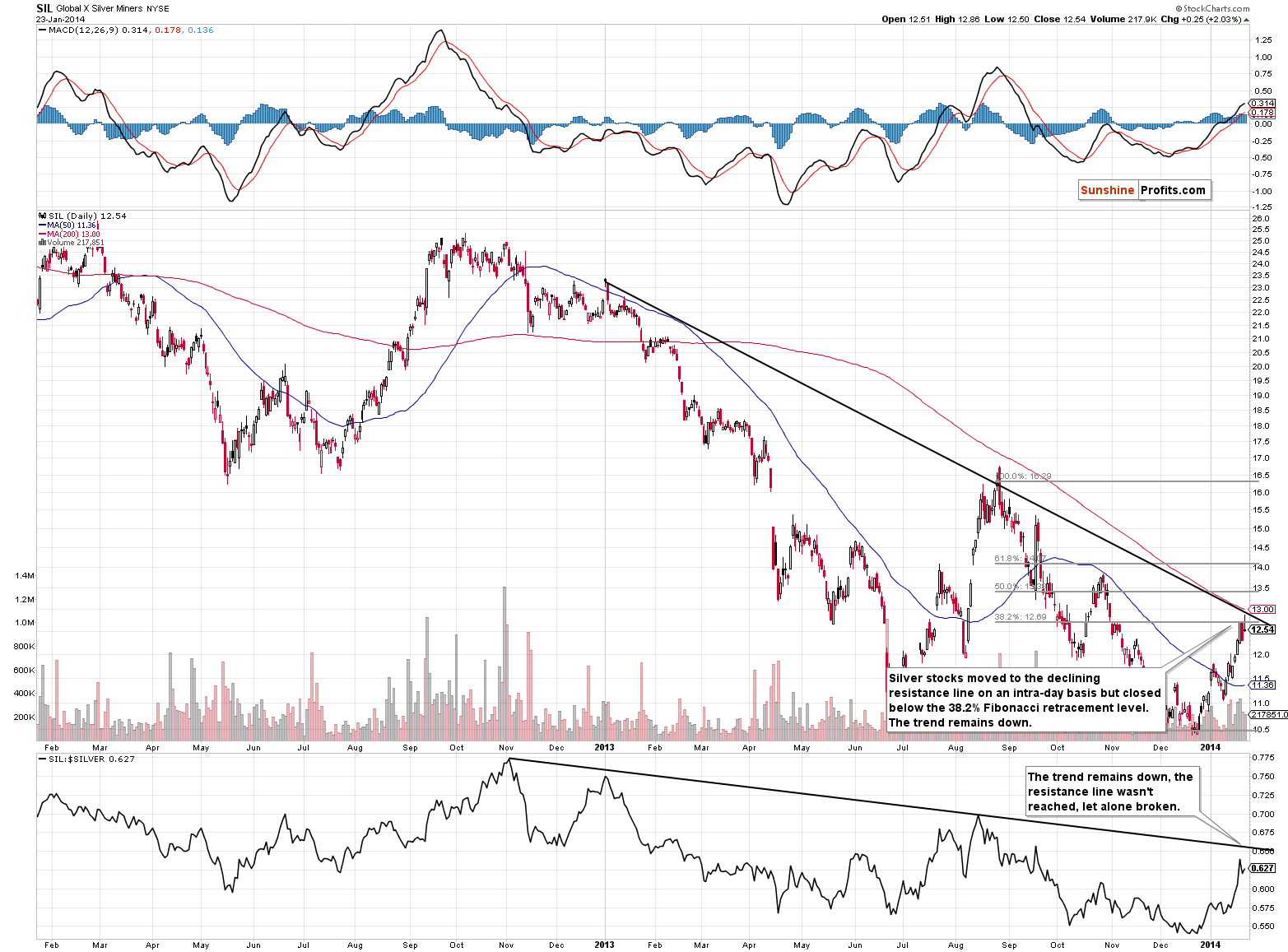
Silver stocks remain in a downtrend.
They corrected to the first of the classic Fibonacci retracement levels, the 38.2% retracement, and declined afterwards (there was an intra-day breakout on Thursday, but the move didn’t hold and silver miners closed below the retracement). This means that the trend remains down and all that what we saw was a correction.
The declining resistance lines (for silver stocks, and for their ratio to silver, which you can see in the lower part of the chart) were not broken and the trend remains down also from this perspective.
There is no doubt that a significant, counter-trend daily slide in the USD index was one of the factors contributing to higher precious metals prices on Thursday.
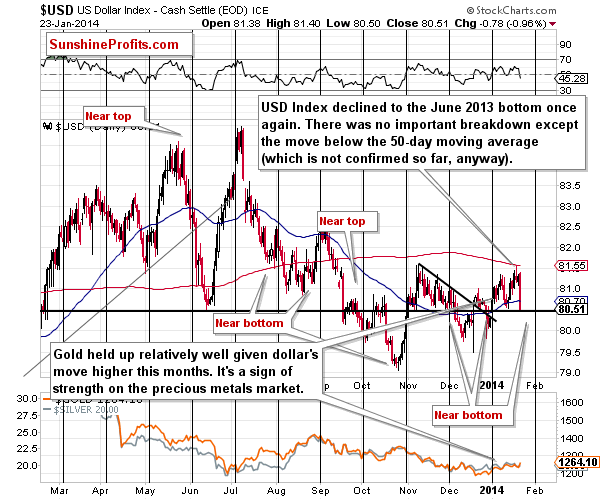
The USD Index but declined right to the horizontal support level created by the June 2013 low. The medium- and long-term trends are up, so it’s quite likely that the big surprises will be to the upside – please note that overall it’s been the case since late October 2013. Will the USD Index rally immediately? At this time the situation is unclear, but things may change quite soon.
On a side note, you may wonder how it is possible for the US dollar to be in a long-term uptrend since there is an open-ended QE in place (and the taperie was very small). The reason is that the USD Index is a weighted average of currency exchange rates, and each rate compares USD to another fiat currency. If these other currencies decline faster than the US Dollar (remember the massive money-printing program by the Bank of Japan?), then the USD Index will rally.
The last, but definitely not the least important chart for today might seem a bit complicated at first, but please take some time to examine it.
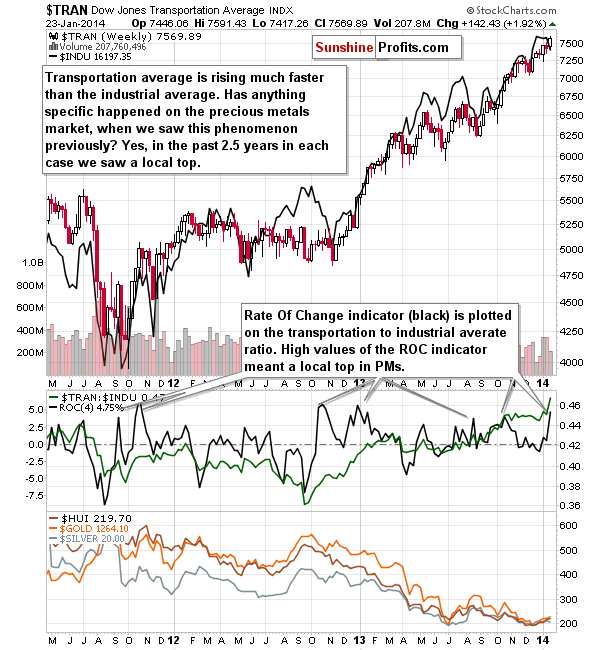
The above chart features the Dow Jones Transportation Average and its values relative to the Dow Jones Industrial Average.
The ratio has moved sharply higher recently, which means that while the DJIA didn’t move much higher, the DJTA did. At this point, you may be asking yourself, why should you – a precious metals investor – bother with such ratio. The answer is: because you are probably interested in estimating when a local top in gold, silver and mining stocks is forming, and a sharp rally in the presented ratio has signaled 6 out of 6 times a top materialized since mid-2011.
Of course, 6 cases don’t prove anything, but it seems that there is a quite significant tendency and we should not ignore it. Naturally, not all moves higher in the DJTA to DJIA ratio will have this effect – the above chart suggests that only the most significant moves are that meaningful. Smaller rallies don’t have the same effect (or at least it’s not that strong).
In the middle of the chart you can see the ratio (green line) and the Rate of Change indicator plotted on it – when this indicator is high, the rally is sharp, which is exactly why we used it.
Summing up, taking all of the above into account, we get the same final result we got after analyzing two first charts dedicated to gold. The very short term (the next few days) is still rather unclear with a bullish bias, but the medium term seems to be still down. If the HUI Index invalidates the breakout in terms of daily closing prices, we will quite likely suggest opening short positions (unless something else happens that will invalidate such a signal).
To summarize:
- Trading capital: No positions.
- Long-term capital: No positions.
As always, we'll keep you - our subscribers - updated should our views on the market change. We will continue to send out Alerts on each trading day and we will send additional Gold & Silver Trading Alerts whenever appropriate.
The trading position presented above is the netted version of positions based on subjective signals from your Editor, and the automated tools (SP Indicators and the upcoming self-similarity-based tool).
As a reminder, Gold & Silver Trading Alerts are posted before or on each trading day (we usually post them before the opening bell, but we don't promise doing that each day). If there's anything urgent, we will send you an additional small alert before posting the main one.
Thank you.
Sincerely,
Przemyslaw Radomski, CFA


